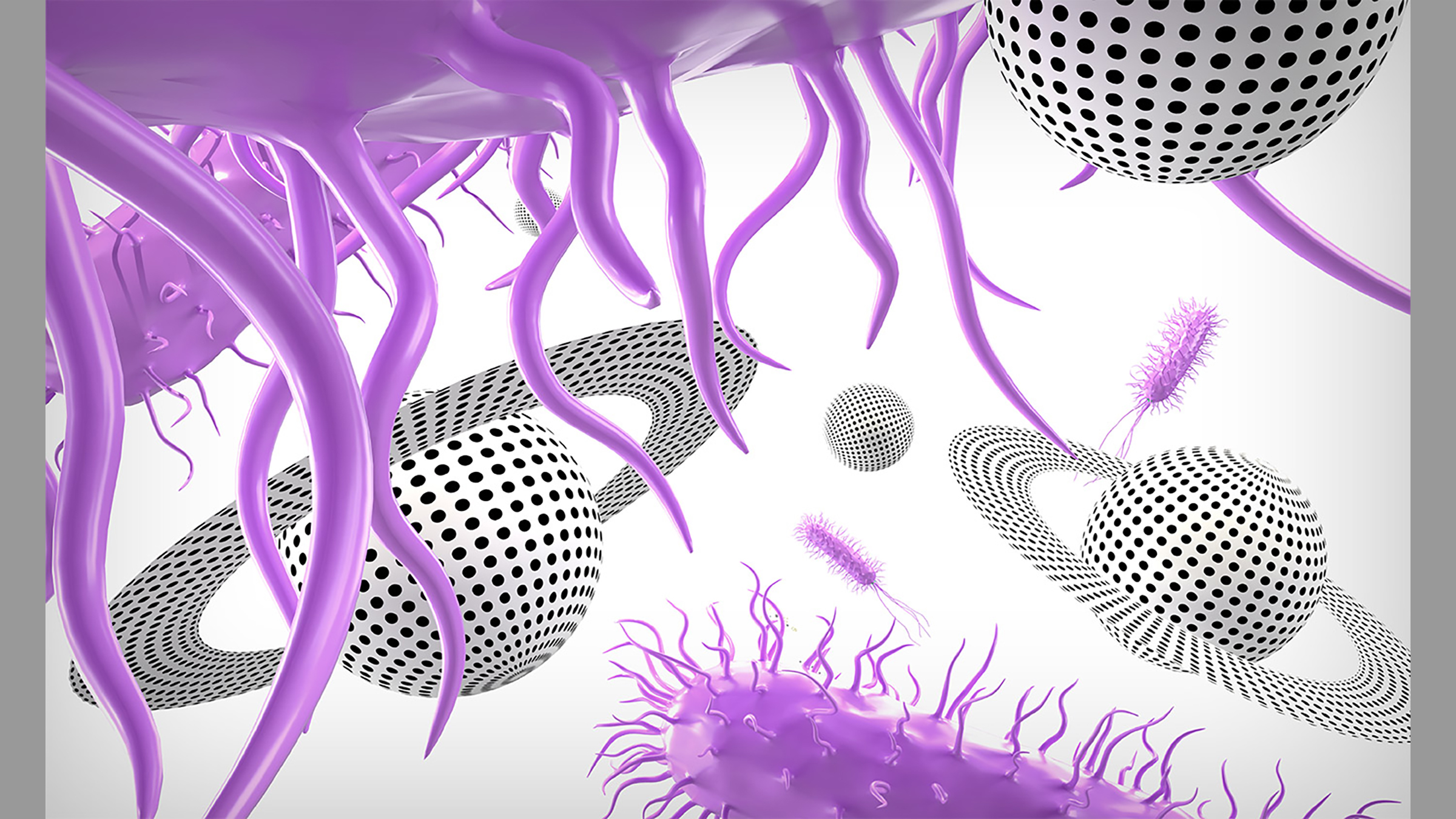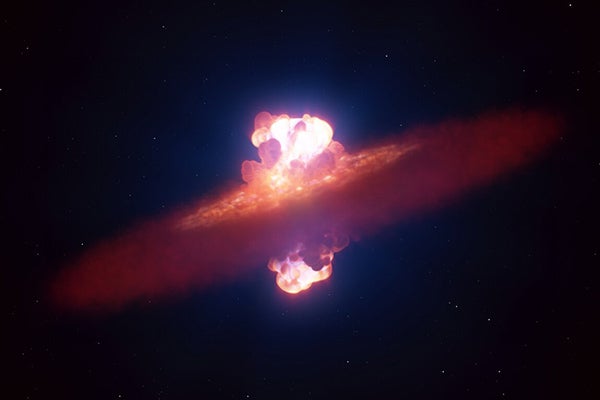The Next 50 Years: Anybody Out There?
Astronomer Caroline Morley speculates on the possibility of finding life on other planets in the near future.

In these next few decades, will humans finally find life in space? We asked University of Texas at Austin astronomer Caroline Morley and her answer just might surprise you. Morley shares her vision for the future in this latest episode of our miniseries, The Next 50 Years.
Scientists from across UT Austin are joining forces in the hunt for life on other planets. Astronomers, geoscientists, chemists, biologists and aerospace engineers have pooled resources to form the UT Center for Planetary Systems Habitability, a cross-campus, interdisciplinary research unit.
Show Notes
Music for today's show was produced by:
Podington Bear - https://www.podingtonbear.com/
Chuzausen - https://freemusicarchive.org/music/Chuzausen
TRANSCRIPT
The Next 50 Years: Anybody Out There?
Marc Airhart: This is Marc Airhart for Point of Discovery. We're continuing The Next 50 Years series, which explores the visions that scientists have for our future. Today's question: In these next few decades, will humans finally find life in space?
Caroline Morley: I am an optimist about this, I think in some sense, to drive your whole career around this question, in some ways you have to be an optimist, I'm amazed by pessimists who can do it anyway. I would give it a 9 out of 10 that we'll find life in the next three decades.
MA: So in your career?
CM: Yes, certainly in my career.
MA: That's Caroline Morley, an assistant professor of astronomy at the University of Texas at Austin. In our galaxy alone, astronomers estimate that there are BILLIONS of planets. That's a LOT of real estate. So how on Earth do astronomers go about searching for biological needles in a haystack? Morley says the first step is to weed out all the places that would be really hard for life to survive.
CM: So the first thing I would look for is a planet that has a rocky surface, like the earth has a rocky surface that has, you know, we have oceans on the surface of our Earth, but we're mostly as a planet made of rock and iron. We think you need to form life on a rocky surface, the gas planets are just not good places where we would start to get those chemical reactions and form life.
MA: Okay, so if it's not rocky, it's out.
CM: The second thing is being the right distance from the star. And so that will actually be different for each star that you look at. So we know the sun is this star that's 5800 Kelvin and we happen to be exactly the right distance from our lovely kind of mid-temperature star to be able to have liquid water on our surface. You definitely need a liquid to be able to transport materials and actually have them react and have chemical reactions and then biological reactions. And water has a lot of different properties that make it one of the best kinds of liquids to have these kinds of reactions in.
MA: Okay, so if a planet's too hot or too cold to have liquid water, it's out.
CM: But if we were orbiting a different kind of star, so the most common stars in our galaxy are actually these little tiny stars that are much cooler than the sun. Most of their light actually comes out not at visible wavelengths where we can see, but in the infrared. We would need to be much, much closer to such a small, faint, dim star to be able to have enough light from that star on our surface to actually have liquid water on the surface.
MA: It turns out that these smaller, redder stars are super common in our galaxy. There are tens of billions of them. And many of them likely have planets. But they also tend to have violent flares of x-rays which might destroy their atmospheres and wipe out life.
CM: Earth is the only planet we know of with life on it. And so we know that it's possible to form life on a little rocky planet, the right distance from a star like the Sun. People talk about this at meetings should we only focus on looking at those very similar systems to us? Or should we imagine these very different systems? Or are there deal breakers for those systems that mean that life just will never form there?
MA: Over the next decade, new instruments will help answer the question of whether astronomers should keep on the list of possible homes for life these planets around small, red stars. One of those instruments is NASA's soon-to-launch James Webb Space Telescope, which has astronomers very excited.
CM: One of the big questions is a very simple question, do the planets around these small stars actually keep their atmospheres for billions of years? We just don't know that. And that's a really scary thing not to know, if you're going to try and design a mission that can detect life using a huge amount of resources, but James Webb will allow us to actually be able to detect the atmosphere of a rocky planet for the first time.
MA: Morley and others will be able to tell for the first time whether these planets around small, red stars have greenhouse gases like carbon dioxide and methane in their atmospheres, as well as steam. This will help astronomers narrow their list of planetary targets even further. But being ABLE to support life and actually HAVING life are two very different things. In a moment, we'll talk about the kinds of telltale signs that could lead to the first discovery of life in space.
MA: For astronomers looking for life, one of the flashing red lights would be the element oxygen. That's because oxygen is unusually abundant in our own atmosphere. The fact that there's so much oxygen here on Earth has to do with an ancient battle between two different groups of microbes.
CM: Yeah, so we know that on Earth, life has dramatically changed, for example, the composition of Earth's atmosphere.
MA: Based on the chemical composition of ancient rocks, scientists think that when the first lifeforms arose on Earth, the atmosphere had a lot of carbon dioxide and almost no oxygen. The first microbes probably didn't have any use for oxygen. But then around 2 and a half billion years ago, a new kind of life appeared. These new microbes could convert sunlight and carbon dioxide into energy and oxygen. They could photosynthesize. These two kinds of life did not get along.
CM: And then when all of this oxygen started forming from this set of organisms, it actually killed many of the other organisms on Earth. So it's a really dramatic event when it happened because the oxygen that these organisms were making was actually toxic to all of these other organisms that had evolved first on earth. And since then, of course, our atmosphere is now mostly nitrogen with about 20% oxygen. So life has totally transformed what the composition of the atmosphere is.
MA: Unusually high levels of oxygen on an extrasolar planet might indicate life. In a few years, astronomers expect to have a new instrument that would help them find such a signal in extrasolar planet atmospheres. It's called the Giant Magellan Telescope and is being built on a mountaintop in Chile. The University of Texas at Austin is a partner in the project. Morley says there are other possible signatures of life that astronomers could look for. For example, when Earth's first life forms arose, oxygen levels were still very low.
CM: And Earth, of course, would have looked very different depending on what era of Earth's history, we looked at it. All of the life that was initially on Earth was underwater, because we didn't have the ozone layer to protect the surface. And so anything that formed on the surface would just be destroyed by UV radiation right away. And so it wasn't until billions of years into Earth's history that we actually had this planet that looks the way it does with a nitrogen-oxygen atmosphere with trees covering the whole surface. It's really only this last snapshot, this last 500 million years out of Earth's four and a half billion-year history that Earth has looked familiar to what we think of it today.
MA: Wow. Okay. So when you're looking out for possible life elsewhere, you can't just be looking for what Earth looks like today. Even if you're just looking for something like earthly life, you'd also have to be looking at the history of Earth and the other possible eras that that the atmosphere might have gone through.
CM: Right. And so one of the things that people are working on studying right now is what exactly Earth actually looked like, which is very hard to know, right? We can't just go back in time and know what Earth looked like back in Earth's history. And so we have to piece together the evidence from geology on Earth and put together that record that's one of the things that's guiding our future missions that we design is knowing how much Earth has changed and making sure that whatever mission we fly to look for life will consider the whole range of Earth's history from when life was first forming 4 billion years ago to the present, and also a wider range than that, because other planets might be quite different themselves.
MA: I asked Morley how she might feel if and when life is finally discovered out in the vastness of space.
CM: The obvious answer is that I would be incredibly excited on the day that evidence for life is found. But I circle back to this idea that when we first find evidence for life, it's not going to be smoking gun, definitive evidence. And so as a scientist, I think I would be both excited but also skeptical at the same time and I would have to grapple with those emotions, right, that I have been, you know, taught over my career to analyze everything very carefully and make sure that it's definitive and real. It would be thrilling to be part of that team, right, that saw that signal for the first time, and realize that it really could be life and … we would start with every possible explanation for whatever signal we're seeing, and then gradually cross things off one by one, and make sure that life was really the only thing left on the list. And so I think it would be, it would be this mix of a huge amount of excitement, but with a lot of apprehension as well.
MA: Hey, listeners, I have a special request. Do you have a burning question about COVID-19? On our next episode of Point of Discovery, we'll ask the experts. Record your question on your phone and email it to utexasscience@gmail.com. Here's an example:
RA: Hi. I'm Ruby in Austin, Texas. When's the soonest we could get a coronavirus vaccine?
MA: Please keep your recordings to 20 seconds or less if you can. We'll be taking these to our experts in mid June, so please get those questions in soon.
MA: Point of Discovery is a production of the University of Texas at Austin's College of Natural Sciences. Music for today's show is by Chuzausen and by Podington Bear. To read a transcript of this show — or find links to more podcasts and essays in The Next 50 Years series — visit us on our website at pointofdiscovery.org. If you like what you heard, be sure and tell your friends. We're available wherever you get your podcasts, including Apple Podcasts, Google Podcasts, Stitcher and Spotify. Our senior producer is Christine Sinatra. I'm your host and producer Marc Airhart. See you in the future!



